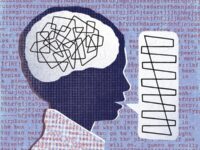Our brains are amazing. We use them to store and process a variety of information, react better, learn to respond to our environment more efficiently, and survive. Emotions play a large part in this. These reactions to stimuli are processed by the brain, inducing a physiological reaction and emotional response. Oftentimes, these emotions are regulated by the brain, but when they aren’t, these emotions — either in excess or deficit — can cause psychological disorders. Looking at fear processing can provide insight into how this may occur.
Fear is one of the most complex pieces of information our brain processes. This primal feeling has kept the human race alive, acting as a warning to escape or protect ourselves from danger. How exactly does this occur? When something from the environment stimulates a fear response, it is first received by a region of the brain called the thalamus, which acts as a gateway that distributes signals to other relevant regions of the brain to initiate an appropriate response.
One major region of the brain’s limbic system, the amygdala, is responsible for processing these stimuli and sending signals to the rest of the body, initiating physiological and behavioral reactions. A 1995 study conducted by Yale University supports this connection between the amygdala and fear. In the experiment, researchers found that in order to produce a fear response (measured by physiological changes such as increased heartbeat), the lateral nucleus and the basolateral complex of the amygdala are necessary for relaying sensory information from receptors, such as eyes, to the central nucleus of the amygdala for the receiving and processing of fear stimuli.
Once the amygdala has processed the fear stimulus, it will send neurochemical signals to other regions in the brain as well as to the endocrine system, which is regulated by the hypothalamus and the pituitary gland. This activation of our sympathetic nervous system serves to release hormones in the body, which is important for initiating the stress response in the body and inducing the physiological feelings related to fear (including increased heartbeat, blood pressure, alertness). This prepares the body to handle the source of fear.
The brain’s prefrontal cortex, responsible for our higher-level thinking capacity, also works in regulating our fear responses. Unlike the amygdala, the prefrontal cortex primarily functions to reduce the body’s response to fear stimuli and to help the brain in controlling emotional responses.
Although activation of the amygdala is important for generating fear and detecting threats, a hyperactive amygdala has been linked to anxiety in adults.
Because there are many different processes and structures that work to regulate fear in the brain, there are also many different ways for it to go wrong. The amygdala’s function, for example, requires a delicate amount of sensitivity. Although activation of the amygdala is important for generating fear and detecting threats, a hyperactive amygdala has been linked to anxiety in adults. Similarly, hyperactivity in the right prefrontal cortex has also been associated with anxiety. This abnormal amount of stress put on the body is detrimental to both a person’s physical and psychological health, creating feelings of constant uneasiness and fatigue, inhibiting their ability to function in daily life. Alternatively, a dysfunctional or damaged amygdala could potentially result in reduced fear and an inability to detect fear from others.
No matter how amazing our brains are, they are still susceptible to glitches. As with other chemical processes and emotions, fear is a feeling that the brain must carefully regulate to keep us functioning properly in our daily lives.
Sources:
NeuroImage (2021). DOI: 10.1016/j.neuroimage.2020.117686
Dialogues in Clinical Neuroscience (2002). DOI: 10.31887/DCNS.2002.4.3/tsteimer
The Journal of Neuroscience (1995). DOI: 10.1523/JNEUROSCI.15-03-02301.1995
Neuropsychologia (2011). DOI: 10.1016/j.neuropsychologia.2010.09.028
Biological Sciences (1999). DOI: 10.1098/rspb.1999.0945
Image courtesy of Pixabay



